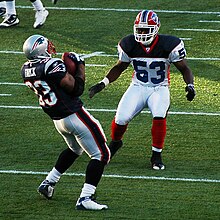Fair catch
The fair catch is a game situation in American football in which a player is allowed to catch the ball without being disturbed. The player of the receiving team may catch a punt or kickoff from the air after waving above head height without being disturbed by the opponents. You may not tackle it even after it has been caught and the play ends where the ball was caught.
procedure
To claim a fair catch, the receiving team player must wave one arm well above head height. If the catching player is attacked by the kicking team after the signal has been given and while the ball is being received, this will be assessed as a personal foul ("kick catch interference") against the attacker. If the catcher only touches the ball without being able to bring it under control, then this is a muff and the ball remains (kickoff) or becomes free (punt) and can be captured by players of both teams.
If the catcher has successfully carried out the fair catch, he can no longer gain space, since the turn ends with catching the ball.
Fair catch kick
After a fair catch has Receiving team the option of the football from the trap of a field goal to use ( "After a fair catch, the receiving team has the option to put the ball in play by a snap or a fair catch kick (field goal attempt) "). Since fair catches are only possible after kickoffs and punts, the distance to the opposing goal is usually too great. And if it is not too big, but there is still some time left until halftime or the end of the game, it is not kicked, but snapped and tries to get a little closer to the goal in order to try a field goal when the time is running out. In the history of the National Football League (NFL), there has been seldom a fair catch kick and only five of them have been successful.
Origins
In the early days of football, when it separated from rugby, it was allowed to catch the ball with your hand in the air and put it on the ground (fair catch). Only then did the ball have to be played with the feet.
This rule was included in the first binding football rules of 1848 and was not abolished until 1871. From then on, only the goalkeeper was allowed to put his hand on the ball, but still in his entire own half of the game, the restriction to his own penalty area did not take place until 1912.
Individual evidence
- ^ Early Rules of Soccer. (No longer available online.) In: soccer.mistral.co.uk. Archived from the original on September 27, 2016 ; accessed on July 1, 2013 (English): “8. When a player catches the ball directly from the foot, he may kick it as he can without running with it. In no other case, the ball may be touched with the hands, except to stop it. " Info: The archive link was automatically inserted and not yet checked. Please check the original and archive link according to the instructions and then remove this notice.
